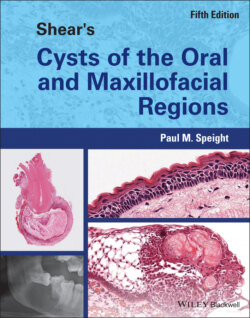Читать книгу Shear's Cysts of the Oral and Maxillofacial Regions - Paul M. Speight - Страница 72
Mandibular buccal bifurcation cyst
ОглавлениеArises on mandibular first or second molars
Often has symptoms – swelling, pain, and there may be suppuration
The associated tooth is vital
Well‐demarcated and corticated radiolucency
10–20 mm in diameter
Lies on the buccal aspect of the tooth root and bifurcation
The periodontal space and lamina dura are intact
Buccal expansion is common
Subperiosteal new bone (visible especially on occlusal radiographs) may be deposited in a laminated pattern
The tooth is tilted buccally and the root apices may abut onto the lingual cortical plate
Figure 4.2 Paradental cysts. (a) Bilateral cysts in a 13‐year‐old associated with recently erupted second molars. The third molars were absent. (b) Two cysts in different patients associated with partially erupted (left) and recently erupted (right) third molars. In all cases, the cysts are distal and buccal to the involved teeth. The distal part of the cyst is separate from the distinct distal follicular space (arrows in a) and the periodontal ligament space and lamina dura are intact (arrowheads).
Source: Vedtofte P 1989, p. 182–188 / with permission of Elsevier. Courtesy of CV Mosby Co.
Although most lesions are located in a buccal or disto‐buccal location (Figure 4.2), Colgan et al. (2002 ) suggested that the precise site of the cyst may depend on the angle of impaction of the associated tooth. A distoangular impaction was shown in 10 of their 15 teeth and all had cysts located towards the distal aspect. Two of their cysts were located towards the mesial aspect of the teeth, but both showed mesioangular impactions. Two teeth that were vertically impacted had cysts located purely on the buccal aspect. The vast majority of reports of paradental cysts record that cysts are located towards the distal aspect of the teeth and that a mesial orientation is rare (Craig 1976 ; Ackermann et al. 1987 ; Vedtofte and Praetorius 1989 ; Philipsen et al. 2004 ). Since most impacted third molars are mesioangular, these data suggest that a distally impacted tooth is more likely to give rise to a paradental cyst than a mesially angled tooth.
Radiological examination of the mandibular buccal bifurcation cyst should include occlusal and panoramic radiographs or CBCT. The cyst presents as a well‐demarcated and usually corticated radiolucency overlying the buccal aspects of the roots of an erupting or recently erupted first or second molar tooth (Figure 4.3). The inferior margin of the cyst is concave and rarely the cyst may extend to the inferior border of the mandible, but does not lead to distortion of the lower border or to an external deformity (Figure 4.3a). There may be involvement of the bone in the furcation and inter‐radicular bone may be lost. In the inter‐radicular region, therefore, the lamina dura may be lost, but the periodontal ligament space and the lamina dura are intact on the mesial and distal aspects of the roots (Figure 4.3), a feature that enables distinction from a radicular cyst.
Figure 4.3 Mandibular buccal bifurcation cysts involving (a) an erupting first permanent molar and (b) a second permanent molar. The cysts are well demarcated and corticated and overly the buccal and periapical aspects of the tooth roots. The periodontal ligament and lamina dura are intact (arrows).
Sources: (a) Courtesy of Dr Douglas W Stoneman. (b) Courtesy of Prof Paul Speight (Previously published: El‐Naggar AK 2017, Courtesy of IARC).
Buccal expansion is often apparent and with involvement of the periosteum new bone may be laid down, either as a single linear band or in a laminated pattern (Figure 4.4). This pattern of laminated new bone is seen as a result of periostitis and is also seen in chronic osteomyelitis. Wolf and Hietanen (1990 ) noted this feature and suggested that clinically and radiographically, the mandibular buccal bifurcation cyst may be similar to osteomyelitis, and that in some cases the cyst may be a cause of chronic osteomyelitis, (sometimes referred to as Garré's osteomyelitis or periostitis ossificans).
CBCT is especially useful in the diagnosis of mandibular buccal bifurcation cysts because it allows the buccal expansion and extent of the lesion to be fully visualised (Ramos et al. 2012 ; Bautista et al. 2019 ; Dave et al. 2020 ). Magnetic resonance imaging (MRI) can also be useful, but although it has the advantage of lower radiation dosage, it has very limited use in routine examination of jaw lesions in dentistry. CBCT shows a hypodense, well‐demarcated, and often spherical cystic lesion with a corticated outline, which is always located on the buccal aspect of the tooth. CBCT and occlusal radiographs show that the affected tooth is tilted buccally and transverse views show the apices abutting and occasionally eroding the lingual cortical plate (Figure 4.4; Bautista et al. 2019 ).
Inflammatory collateral cysts at other sites show similar radiological features. The four cases associated with premolars, reported by Morimoto et al. (2004 ), showed well‐demarcated radiolucencies overlying the buccal aspect of erupting and incompletely formed premolars. There was buccal expansion and in all cases the teeth were displaced lingually. Cysts in the globulomaxillary region present as a well‐demarcated radiolucency between the lateral incisor and the canine tooth. The cyst has an ‘inverted pear’ shape and the tooth roots are displaced and diverge. All eight cases reported by Vedtofte and Holmstrup (1989 ) showed these features and in all cases both the canine and incisor tooth were fully erupted.
